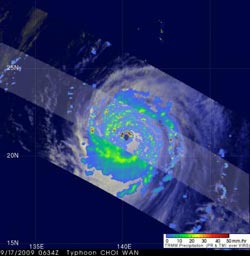NASA's TRMM satellite sees heavy rainfall in Choi-Wan

TRMM captured Super Typhoon Choi-Wan heavy rainfall on Sept. 17 at 2:34 a.m. EDT. The yellow and green areas indicate moderate rainfall between .78 to 1.57 inches per hour. Red areas near Choi-Wan\'s center are considered heavy rainfall at almost 2 inches per hour. Credit: NASA/SSAI, Hal Pierce
TRMM rainfall images are false-colored with yellow, green and red areas, which indicate rainfall between 20 and 40 millimeters (.78 to 1.57 inches) per hour.
Dark red areas are considered heavy rainfall, as much as 2 inches of rain per hour.
Rain rates in the center of the swath are from the TRMM Precipitation Radar (PR), the only spaceborne radar of its kind, while those in the outer portion are from the TRMM Microwave Imager (TMI).
The rain rates are overlaid on infrared (IR) data from the TRMM Visible Infrared Scanner (VIRS).
Media Contact
All latest news from the category: Information Technology
Here you can find a summary of innovations in the fields of information and data processing and up-to-date developments on IT equipment and hardware.
This area covers topics such as IT services, IT architectures, IT management and telecommunications.
Newest articles

Why getting in touch with our ‘gerbil brain’ could help machines listen better
Macquarie University researchers have debunked a 75-year-old theory about how humans determine where sounds are coming from, and it could unlock the secret to creating a next generation of more…

Attosecond core-level spectroscopy reveals real-time molecular dynamics
Chemical reactions are complex mechanisms. Many different dynamical processes are involved, affecting both the electrons and the nucleus of the present atoms. Very often the strongly coupled electron and nuclear…

Free-forming organelles help plants adapt to climate change
Scientists uncover how plants “see” shades of light, temperature. Plants’ ability to sense light and temperature, and their ability to adapt to climate change, hinges on free-forming structures in their…





















